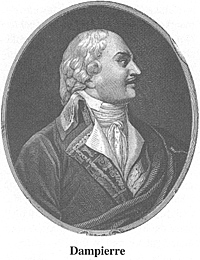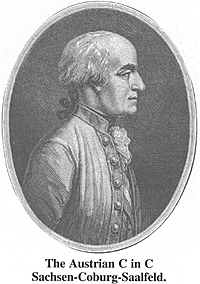Battle of Aldenhoven /
Aix-La-Chapelle, 1793
Dutch During the
Revolutionary Wars Part 13
Positions and Dispositions
by Geert van Uythoven, Netherlands
| |
French PositionsThe French forces opposing the Austrian main army were positioned behind the rivers Ruhr (‘Roer’) and Erft between Düren and Jülich, on a front of nearly 20 kilometres wide. The Ruhr valley had an average height of about 80 m above sea level. To the west, the terrain rose to a plateau with a height of 100-120 m. It consisted mainly of moor land, with small patches of wood. The bases of the French defence were the cities Aachen (Aix-la-Chapelle) and Rolduc. In front of these points, up to the rivers Ruhr and Erft, the Avant-garde and both Flanqueurs ‘detachments’ of the Armée de la Belgique defended a number of entrenchments, villages and outposts. The French were just over 18,000 men strong, consisting of the Avant-garde commanded by Lieutenant-General de la Noüe. De la Noüe was interim commander of the Armée de la Belgique during the absence of its interim commander Lieutenant-General Jean-Baptiste-Cyrus-Marie-Adélaide de Timbrunne de Theimbronnen, comte de Valence, who on his turn commanded the Armée de la Belgique during the absence of Dumouriez. Beside the Avant-garde the French forces consisted of the Flanqueurs de gauche commanded by maréchal de camp Joseph, comte Miaczynski, and the Flanqueurs de droite commanded by Colonel Jean-Henry-Guy-Nicolas de Grandval, marquis de Frégeville (‘the elder’, his younger brother also serving in the French army). The composition and position of these troops is listed in Table A. However, despite of this order of battle, several positions and strongpoints were entrusted to other commanding officers, as we will see in the description of the battle. These troops opposed the Austrian main army behind the rivers Ruhr and Erft, and would have to sustain the first attacks. The French had erected several redoubts and maintained their outposts as far as the east bank of the river Ruhr. For reasons already mentioned in the previous article the French were dispersed over a wide area; encamped in 57 cantonments! The strongest French defences were placed to block the main roads from the east leading to Aachen. A line of entrenchments and redoubts had been constructed between the villages Röhe and Hehlrath, just west of Eschweiler town. These blocked the road from Düren to Aachen, and included a strong redoubt on the Röhe Hill (‘Röheberg’, also mistakenly called ‘Roerberg’ in many sources, 180 m high). This redoubt dominated the whole valley to the east. In front of these positions, near Weisweiler, more entrenchments had been constructed.
As we already have seen, this was the highest part of the plateau, dominating the terrain to the east. Opposite Jülich, south of Koslar on the Engelsdorfer Burgacker, another redoubt had been constructed. All the troops here were in effect commanded by Lieutenant-General de la Noüe. The French main force would concentrate at Höngen. The French positions were exposed and therefore very vulnerable. The Ruhr was no serious obstacle. French forces were dispersed over a much to wide area close to their enemy, and not able to concentrate in time when they would be attacked. In vain, maréchal de camp Auguste-Marie-Henri Picot, marquis de Dampierre, and maréchal de camp Stengel pointed out the danger, proposing to evacuate Aachen and to retreat behind the Meuse. But the representatives made them perfectly clear that a retreat was completely out of the question, and their proposal nearly treason! Completely in their revolutionary style, the French had ‘freed’ the region, and in addition Aachen, as the capital of Charlemagne, could not be abandoned! Austrian Dispositions for the Attack
For example, several squadrons of the Chevau-léger Regiment No. 31 “Latour", part of the 2. Treffen, reinforced the Avant-Garde during the battle, being put under direct command of the Archduke Charles leading that Avant-Garde. A clear proof of the flexibility the Austrian army had, contrary to popular belief. From the information I found I have constructed the composition as listed in Table B. The attack would be executed by the Avant-Garde, commanded by the then 22-year old Karl Ludwig Johann, Erzherzog von Österreich (‘Archduke Charles’), and the Hauptkorps (‘main force’), consisting of two Treffen (‘battle lines’). The Linke Flanke (‘left wing’), commanded by FML Prinz von Württemberg, would initially secure the left flank of the army [1] , while the Rechte Flanke (‘right wing’), commanded by FML Maximilian Graf Baillet von Latour and which stood in front of Linnich would secure the right, support the Prussians in their attack, and finally capture Wassenberg and Roermond. Major General von Wenkheim would support the Prussian attack on French defences behind the Swalme brook, and stayed for the time being in position at the village Erkelenz to cover the Austrian far right. The Austrian
army was heavy in skirmishers capability.
Except for the Tyrolean Jäger, several Freikorps and jäger battalions added their men to the skirmisher line with, as we will see, decisive effect. It is difficult to ascertain which specific units were engaged in certain combats, as all sources speak of Schützen (‘skirmishers’), regardless of the unit they derived from. More correct, I will refer to them as ‘light infantry’. During the night of 1 March the Austrians started their advance. The Ruhr was swollen and not fordable for infantry. Therefore, the Austrians had to use the existing bridges, or construct bridges themselves in order to cross.
The first attack would be made at dawn by the forces crossing at Düren; the Avant-Garde, the Linke Flanke, and the 2. Treffen crossed the Ruhr using the stone arch bridge still intact. They would be led by FM Sachsen-Coburg-Saalfeld himself. His objective was Eschweiler. The remaining columns (1. Treffen led by FZM Karl Joseph Graf Clerfayt, who also commanded all troops crossing at this point, and the Rechte Flanke) would cross just north of Jülich. Clerfayt’s objective was Aldenhoven. Orders were to wait until 09.00 am with the attack proper, giving the troops that crossed at Düren the chance to clear away all opposition near the river first.
According to some sources the French were totally surprised; others say they were not. I believe the latter, enough proof indicating that the French knew that the Austrians were preparing an attack, but maybe not knowing the right date In any case, the French troops in Eschweiler seems to have been alarmed around 08.00 am, when the Austrians were already well established on the French side of the Ruhr.
Battle of Aldenhoven / Aix-La-Chapelle, 1793 Dutch in Revolutionary Wars Part 13
The Dutch During the Revolutionary Wars
|

 The French here were commanded by maréchal de camp Henri-Christian-Michel, baron de Stengel, who had his headquarters in Aachen. South of the village Höngen on the ‘Begau’, to the west of the village Aldenhoven, a line of two great and three smaller redoubts had been constructed during winter 1792-1793, across the road from Jülich to Aachen.
The French here were commanded by maréchal de camp Henri-Christian-Michel, baron de Stengel, who had his headquarters in Aachen. South of the village Höngen on the ‘Begau’, to the west of the village Aldenhoven, a line of two great and three smaller redoubts had been constructed during winter 1792-1793, across the road from Jülich to Aachen.  On 28 February FM Friedrich Josias Prinz von Sachsen-Coburg-Saalfeld started to concentrate his army behind the river Ruhr, about 40,000 men. He planned to surprise the French in their cantonments near Eschweiler and Höngen. The Austrian army was divided into five columns. Sources on the composition of these columns is however greatly contradicting, even the ‘official’ ones! Problem to ascertain which troops were part of which column is even bigger while, during the battle, units were shifted from one column to another when thought necessary.
On 28 February FM Friedrich Josias Prinz von Sachsen-Coburg-Saalfeld started to concentrate his army behind the river Ruhr, about 40,000 men. He planned to surprise the French in their cantonments near Eschweiler and Höngen. The Austrian army was divided into five columns. Sources on the composition of these columns is however greatly contradicting, even the ‘official’ ones! Problem to ascertain which troops were part of which column is even bigger while, during the battle, units were shifted from one column to another when thought necessary.